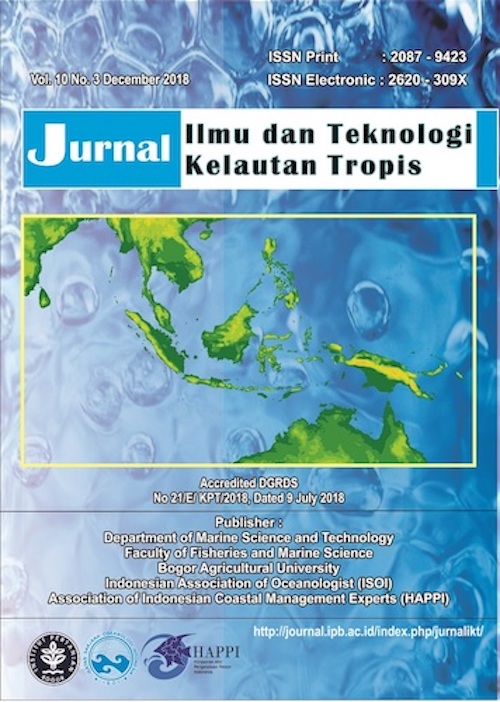PENGARUH KOMPOSISI MINERAL AIR TANAH TERHADAP FISIOLOGI DAN HISTOLOGI UDANG VANAME Litopenaeus vannamei
Abstract
ABSTRAKBanyak petambak udang vaname L. vannamei di pantai utara Jawa menggunakan air tanah (groundwater) sebagai media budidaya dengan tujuan untuk menghindari berbagai kontaminan. Penelitian ini bertujuan mengevaluasi komposisi mineral utama air tanah di kabupaten Karawang (Jawa Barat), serta pengaruhnya terhadap performa pertumbuhan, fisiologi dan histologi udang vaname. Penelitian dengan metode ex post-facto didasarkan pada pengamatan tiga kolam budidaya selama 83 hari masa pemeliharaan. Antar kolam penelitian terdapat perbedaan nyata (p<0,05) pada parameter salinitas (12-16 ppt), SO42‾ (148-642 mg/L) dan Na/K (26,6-45,2). Hasil penelitian memperlihatkan udang memiliki bobot tubuh rata-rata (ABW) sebesar 8,83; 17,3; dan 18,5 g serta sintasan (SR) sebesar 37,7; 81,7; dan 78,3% masing-masing untuk kolam A, B dan C. Rendahnya ABW dan SR kolam A diperkirakan karena pengaruh infeksi Enterocytozoon hepatopenaei. Udang dari kolam C (Na/K=45,2) memiliki konsentrasi glukosa hemolim lebih tinggi dibanding kolam B (Na/K=26,6), yang mengindikasikan bahwa udang kolam C lebih terpapar stres. Hepatopankreas udang kolam C mengalami beberapa kelainan berupa atrofi tubulus, sloughing cell, dan penurunan jumlah sel sekretori, sementara kelainan tersebut tidak ditemukan pada kolam B. Meskipun relatif tidak ada perbedaan performa pertumbuhan antara kolam B dengan kolam C, namun secara fisiologis dan histologis terdapat perbedaan yang dimungkinkan akibat dari perbedaan rasio Na/K media.
ABSTRACT
Many shrimp farmers on the northern coast of Java used groundwater as a culture media in order to avoid various contaminants. This study aimed to evaluate the major mineral composition of inland saline groundwater (ISGW) in Karawang (West Java, Indonesia) and its effects on the growth, physiology, and histology of L. vannamei. Ex post-facto study was done based on observations of three ponds during 83 days of shrimp culture. Between ponds there were significant differences (p <0.05) on salinity (12-16 ppt), SO42‾ (148-642 mg/L) and Na/K (26.6-45.2). The results showed that shrimp’s average body weight (ABW) and survival rate (SR) of pond A, B and C was 8.83, 17.3, and 18.5 g; and 37.7, 81.7, and 78.3% respectively. The low ABW and SR of pond A were possibly due to the influence of Enterocytozoon hepatopenaei infection. Pond C (Na/K=45.2) significantly has a higher shrimp’s hemolymph glucose concentration than pond B (Na/K=26.6), indicated more exposed to stress. Similarly, shrimp’s hepatopancreas of pond C has some abnormalities that were not found in pond B. Although relatively there was no difference in the growth performance between pond B and pond C, but physiologically and histologically there were some differences that possibly due to the difference in Na/K ratio of the media.
Downloads
The author submitting the manuscript must understand and agree that the copyright of the article manuscript must be submitted/transferred to the Jurnal Ilmu dan Teknologi Kelautan Tropis. This work is licensed under the Creative Commons Attribution-ShareAlike 4.0 (CC BY-SA) International License in which the Author and Reader can copy and redistribute the material in any media or format, and remix, modify and build material for any purpose, but they must provide appropriate credit (citing articles or content), provide a link to the license, and indicate whether there is a change. If you mix, change, or create material, you must distribute your contribution under the same license as the original.



.png)














